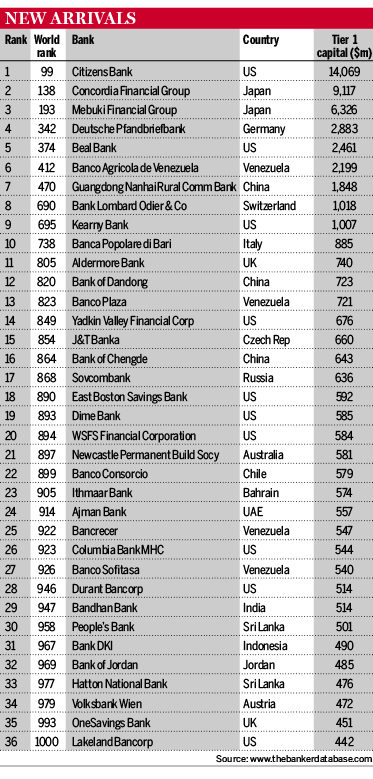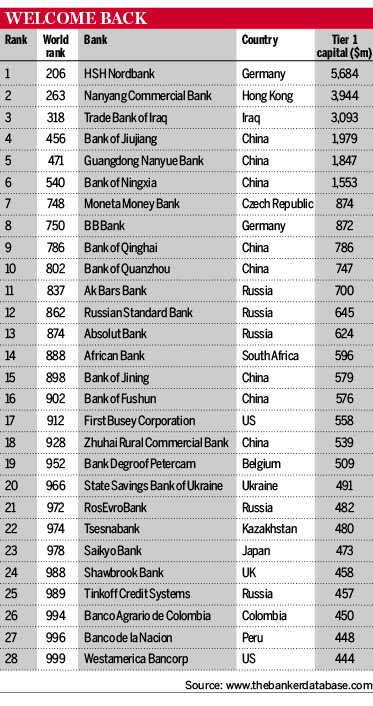The new arrivals table in the 2017 Top 1000 World Banks ranking is a more diverse affair than it was in 2016. In total, banks from 18 markets appear in the list, up from 15 in 2016. Of the 36 institutions entering the Top 1000 World Banks for the first time, 10 are from the US, four are from Venezuela, three from China, two from Sri Lanka and two from the UK. The remaining institutions hail from western Europe, Latin America and the Asia-Pacific region.
The Tier 1 capital positions of the new arrivals in 2017 are also much larger compared with last year’s table. The cumulative Tier 1 capital of the top three this year is about three times larger ($29.5bn) than their predecessors in the 2016 table ($8.9bn). This, in part, reflects some of the significant merger and acquisition activity that has taken place in the largest and most mature banking markets during the review period.
Scooping the top spot in the 2017 new arrivals table is Citizens Bank from the US. Following the Royal Bank of Scotland’s divestment of its position in the lender, Citizens Bank now enters the Top 1000 ranking as an independent institution in a global position of 99 with $14bn in Tier 1 capital.
In second place is Japan’s Concordia Financial Group, a new entity resulting from the merger between Bank of Yokohama and Higashi-Nippon Bank. Boasting $9.1bn in Tier 1 capital, the bank enters this year’s Top 1000 ranking at a global position of 138.
Another Japanese lender, Mebuki Financial Group, rounds off 2017’s top three new arrivals. Formed from the merger of two regional Japanese lenders, Joyo Bank and Ashikaga Holdings, Mebuki Financial Group has $6.2bn in Tier 1 capital.
Germany’s Deutsche Pfandbriefbank takes fourth spot, with $2.8bn in Tier 1 capital and a world ranking of 342. As the re-privatised strategic core bank of the former Hypo Real Estate Group, Deutsche Pfandbriefbank executed an initial public offering in July 2015 to become only the fourth listed bank in Germany. Beal Bank from the US completes the top five new arrivals for 2017, with $2.4bn in Tier 1 capital and a world ranking of 342.
Moving onto the new arrivals from positions five to 10, the market diversifies to include entrants from Venezuela, China, Switzerland and Italy. Banca Popolare di Bari, which rounds off the top 10, is the first Italian bank to feature in the new arrivals table since 2014. With $885m in Tier 1 capital, Banca Popolare di Bari has a global ranking of 738 as a result of its acquisitions of Cassa di Rasparmio di Orvieto, Banca Tercas and Banca Caripe in recent years.
Other notable new entrants include India’s Bandhan Bank with $514m of Tier 1 capital and a world ranking of 947. As part of the Bandhan Group, a microfinance outfit, the bank’s arrival in the 2017 ranking follows an in-principle approval for the creation of a universal bank by the Reserve Bank of India in 2014, before receiving the final confirmation in June 2015.
Elsewhere, Russia’s Sovcombank comes in at 17 on the new arrivals table with $636m in Tier 1 capital. This follows a busy period on the acquisition trail, including Russia’s ICICI Bank in 2015 and Garanti Bank Moscow and Metcombank in 2016.
Sri Lanka’s Hatton National Bank, which comes in at number 33 on the new arrivals list, has finally cracked the Top 1000 World Banks ranking at 977th with $476m in Tier 1 capital. This follows a near miss in the 2016 ranking when the bank hit $403m in Tier 1 capital, with the 1000th largest lender having $404m.
In south-east Asia, Indonesia’s Bank DKI – the regional development bank of Jakarta special regional government – has benefited from extensive capital injections by its governmental parent in recent years. These have been sufficient to propel Bank DKI into the Top 1000 World Banks ranking for the first time, with $490m in Tier 1 capital, a global ranking of 967th and 31st place in the new entrants table.
Meanwhile, the inclusion of three Chinese banks in the new arrival table is an increase on the single Chinese bank featured last year. These institutions are Guangdong Nanhai Rural Commercial Bank (with Tier 1 capital of $1.8bn), the Bank of Dandong (with $723m) and the Bank of Chengde ($643m).
Overall, the 2017 new arrivals table paints a healthy picture of the global banking sector. More geographically diverse than in 2016, the new arrival ranking this year is less dominated by US lenders. Indeed, the fact that nine Asia-Pacific banks feature in the 2017 table, compared with just five last year, highlights the continuing rise of Asian financial institutions in the global league table.
The 2017 ‘welcome back’ table, which recognises banks making their return to the global ranking, has a mix of lenders from 14 different jurisdictions. China dominates, with eight banks, followed by Russia with five lenders returning. Germany and the US both have two, while the remaining institutions hail from Peru, Colombia, Belgium, Ukraine, Czech Republic, the UK, Hong Kong, Japan, Kazakhstan and Iraq. In total, the 2017 welcome back table has 28 lenders, a reduction on the 38 listed in the 2016 ranking.
In common with previous rankings, many big-hitting returners to the Top 1000 with Tier 1 capital positions well above the minimum threshold are usually included as a result of the renewed availability of their financial data. This is true for some lenders, such as the Trade Bank of Iraq with just over $3bn in Tier 1 capital. But for most other banks, sound performance and strong capital provisioning helped get them back into the global rankings.
The presence of five Russian banks is a case in point. With Tier 1 capital positions ranging from $700m for Ak Bars Bank to $457m for Tinkoff Credit Systems, these lenders have benefited from an improving domestic economic environment as well as a strengthening of the rouble. By the end of December 2016, the Russian currency had strengthened by more than 20% against the dollar. This country performance compares favourably with the single Russian bank represented in 2016’s welcome back table.
The eight Chinese banks featured in the 2017 welcome back ranking range from Bank of Jiujiang with $1.9bn in Tier 1 capital, to Zhuhai Rural Commercial Bank with $539m. Their robust showing points to the relatively strong performance of Chinese banks in both the new arrivals and welcome back rankings in 2017 relative to their performance last year.
One African lender features in this year’s welcome back table: African Bank of South Africa. This follows its successful restructuring under the auspices of the South African Reserve Bank. The appointment of a new board, executive team and the introduction of a new mission and strategy all took place in early 2016. The bank returns to the Top 1000 ranking at a global position of 888 and Tier 1 capital of $596m.
At the bottom of this year’s welcome back table, it is an all Americas affair, with banks from Colombia, Peru and the US. Banco Agrario de Colombia, with $450m in Tier 1 capital, comes in at 26 on the list with a global ranking of 994. Peru’s Banco de la Nacion, with $448m in Tier 1 capital, takes a global ranking of 996 and position 27 in the welcome back table. Meanwhile, Westamerica Bancorp from the US comes in at 999 in the global rankings and features at 28th place with $444m in Tier 1 capital.






